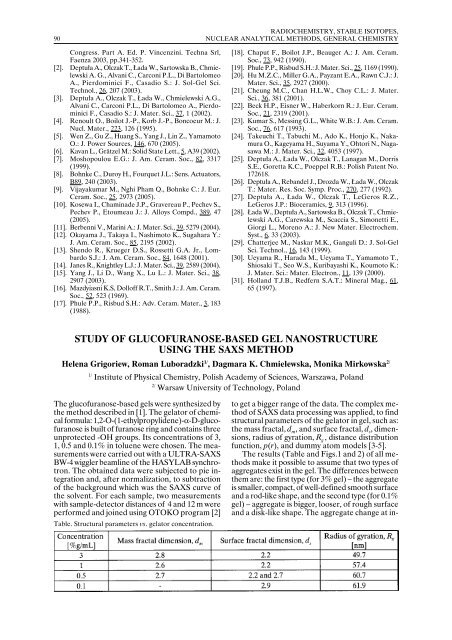annual report annual report annual report annual report 2005
annual report annual report annual report annual report 2005
annual report annual report annual report annual report 2005
Create successful ePaper yourself
Turn your PDF publications into a flip-book with our unique Google optimized e-Paper software.
90<br />
RADIOCHEMISTRY, STABLE ISOTOPES,<br />
NUCLEAR ANALYTICAL METHODS, GENERAL CHEMISTRY<br />
Congress. Part A. Ed. P. Vincenzini. Techna Srl,<br />
Faenza 2003, pp.341-352.<br />
[2]. Deptuła A., Olczak T., Łada W., Sartowska B., Chmielewski<br />
A. G., Alvani C., Carconi P.L., Di Bartolomeo<br />
A., Pierdominici F., Casadio S.: J. Sol-Gel Sci.<br />
Technol., 26, 207 (2003).<br />
[3]. Deptuła A., Olczak T., Łada W., Chmielewski A.G.,<br />
Alvani C., Carconi P.L., Di Bartolomeo A., Pierdominici<br />
F., Casadio S.: J. Mater. Sci., 37, 1 (2002).<br />
[4]. Renoult O., Boilot J.-P., Korb J.-P., Boncoeur M.: J.<br />
Nucl. Mater., 223, 126 (1995).<br />
[5]. Wen Z., Gu Z., Huang S., Yang J., Lin Z., Yamamoto<br />
O.: J. Power Sources, 146, 670 (<strong>2005</strong>).<br />
[6]. Kavan L., Grätzel M.: Solid State Lett., 5, A39 (2002).<br />
[7]. Moshopoulou E.G.: J. Am. Ceram. Soc., 82, 3317<br />
(1999).<br />
[8]. Bohnke C., Duroy H., Fourquet J.L.: Sens. Actuators,<br />
B89, 240 (2003).<br />
[9]. Vijayakumar M., Nghi Pham Q., Bohnke C.: J. Eur.<br />
Ceram. Soc., 25, 2973 (<strong>2005</strong>).<br />
[10]. Kosewa I., Chaminade J.P., Gravereau P., Pechev S.,<br />
Pechev P., Etoumeau J.: J. Alloys Compd., 389, 47<br />
(<strong>2005</strong>).<br />
[11]. Berbenni V., Marini A.: J. Mater. Sci., 39, 5279 (2004).<br />
[12]. Okayama J., Takaya I., Nashimoto K., Sugahara Y.:<br />
J. Am. Ceram. Soc., 85, 2195 (2002).<br />
[13]. Shendo R., Krueger D.S., Rossetti G.A. Jr., Lombardo<br />
S.J.: J. Am. Ceram. Soc., 84, 1648 (2001).<br />
[14]. Janes R., Knightley L.J.: J. Mater. Sci., 39, 2589 (2004).<br />
[15]. Yang J., Li D., Wang X., Lu L.: J. Mater. Sci., 38,<br />
2907 (2003).<br />
[16]. Mazdyiasni K.S, Dolloff R.T., Smith J.: J. Am. Ceram.<br />
Soc., 52, 523 (1969).<br />
[17]. Phule P.P., Risbud S.H.: Adv. Ceram. Mater., 3, 183<br />
(1988).<br />
[18]. Chaput F., Boilot J.P., Beauger A.: J. Am. Ceram.<br />
Soc., 73, 942 (1990).<br />
[19]. Phule P.P., Risbud S.H.: J. Mater. Sci., 25, 1169 (1990).<br />
[20]. Hu M.Z.C., Miller G.A., Payzant E.A., Rawn C.J.: J.<br />
Mater. Sci., 35, 2927 (2000).<br />
[21]. Cheung M.C., Chan H.L.W., Choy C.L.: J. Mater.<br />
Sci., 36, 381 (2001).<br />
[22]. Beck H.P., Eisner W., Haberkorn R.: J. Eur. Ceram.<br />
Soc., 21, 2319 (2001).<br />
[23]. Kumar S., Messing G.L., White W.B.: J. Am. Ceram.<br />
Soc., 76, 617 (1993).<br />
[24]. Takeuchi T., Tabuchi M., Ado K., Honjo K., Nakamura<br />
O., Kageyama H., Suyama Y., Ohtori N., Nagasawa<br />
M.: J. Mater. Sci., 32, 4053 (1997).<br />
[25]. Deptuła A., Łada W., Olczak T., Lanagan M., Dorris<br />
S.E., Goretta K.C., Poeppel R.B.: Polish Patent No.<br />
172618.<br />
[26]. Deptuła A., Rebandel J., Drozda W., Łada W., Olczak<br />
T.: Mater. Res. Soc. Symp. Proc., 270, 277 (1992).<br />
[27]. Deptuła A., Łada W., Olczak T., LeGeros R.Z.,<br />
LeGeros J.P.: Bioceramics, 9, 313 (1996).<br />
[28]. Łada W., Deptuła A., Sartowska B., Olczak T., Chmielewski<br />
A.G., Carewska M., Scaccia S., Simonetti E.,<br />
Giorgi L., Moreno A.: J. New Mater. Electrochem.<br />
Syst., 6, 33 (2003).<br />
[29]. Chatterjee M., Naskar M.K., Ganguli D.: J. Sol-Gel<br />
Sci. Technol., 16, 143 (1999).<br />
[30]. Ueyama R., Harada M., Ueyama T., Yamamoto T.,<br />
Shiosaki T., Seo W.S., Kuribayashi K., Koumoto K.:<br />
J. Mater. Sci.: Mater. Electron., 11, 139 (2000).<br />
[31]. Holland T.J.B., Redfern S.A.T.: Mineral Mag., 61,<br />
65 (1997).<br />
STUDY OF GLUCOFURANOSE-BASED GEL NANOSTRUCTURE<br />
USING THE SAXS METHOD<br />
Helena Grigoriew, Roman Luboradzki 1/ , Dagmara K. Chmielewska, Monika Mirkowska 2/<br />
1/<br />
Institute of Physical Chemistry, Polish Academy of Sciences, Warszawa, Poland<br />
2/<br />
Warsaw University of Technology, Poland<br />
The glucofuranose-based gels were synthesized by<br />
the method described in [1]. The gelator of chemical<br />
formula: 1,2-O-(1-ethylpropylidene)-α-D-glucofuranose<br />
is built of furanose ring and contains three<br />
unprotected -OH groups. Its concentrations of 3,<br />
1, 0.5 and 0.1% in toluene were chosen. The measurements<br />
were carried out with a ULTRA-SAXS<br />
BW-4 wiggler beamline of the HASYLAB synchrotron.<br />
The obtained data were subjected to pie integration<br />
and, after normalization, to subtraction<br />
of the background which was the SAXS curve of<br />
the solvent. For each sample, two measurements<br />
with sample-detector distances of 4 and 12 m were<br />
performed and joined using OTOKO program [2]<br />
Table. Structural parameters vs. gelator concentration.<br />
to get a bigger range of the data. The complex method<br />
of SAXS data processing was applied, to find<br />
structural parameters of the gelator in gel, such as:<br />
the mass fractal, d m , and surface fractal, d s , dimensions,<br />
radius of gyration, R g , distance distribution<br />
function, p(r), and dummy atom models [3-5].<br />
The results (Table and Figs.1 and 2) of all methods<br />
make it possible to assume that two types of<br />
aggregates exist in the gel. The differences between<br />
them are: the first type (for 3% gel) – the aggregate<br />
is smaller, compact, of well-defined smooth surface<br />
and a rod-like shape, and the second type (for 0.1%<br />
gel) – aggregate is bigger, looser, of rough surface<br />
and a disk-like shape. The aggregate change at in-
















